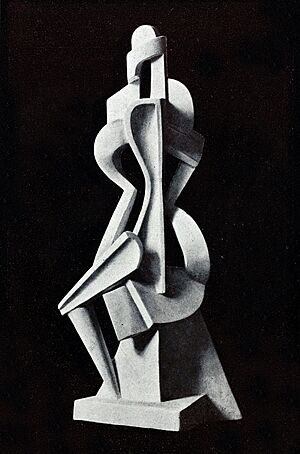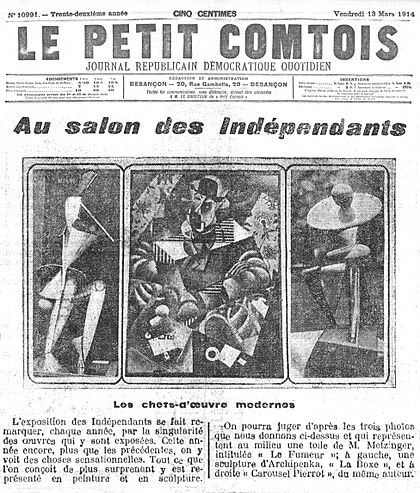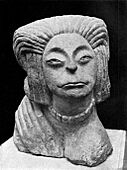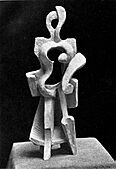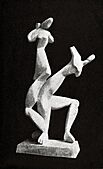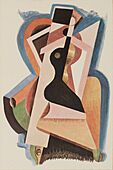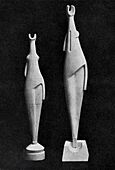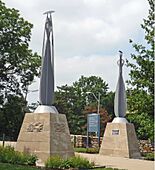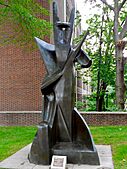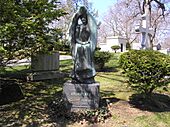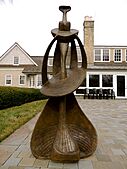Alexander Archipenko facts for kids
Quick facts for kids
Alexander Archipenko
|
|
|---|---|
| Born |
Oleksandr Porfyrovych Arkhypenko
May 30 [O.S. May 18] 1887 |
| Died | February 25, 1964 (aged 76) New York City, New York U.S.
|
| Education | Kyiv Art School |
| Known for | Sculpture |
|
Notable work
|
The Boxers, 1914 |
| Movement | Cubism |
| Elected | American Academy of Arts and Letters (1962) |
Alexander Archipenko (born May 30, 1887 – died February 25, 1964) was a famous Ukrainian-American artist. He was a sculptor and graphic artist. Archipenko was known for being one of the first artists to use the ideas of Cubism in his sculptures. He broke down human shapes into simple geometric forms. He worked in France and the United States.
Contents
The Life of Alexander Archipenko
Alexander Archipenko was born in Kyiv, which was then part of the Russian Empire and is now in Ukraine. This happened in 1887. His parents were Porfiry Antonowych Archipenko and Poroskowia Vassylivna Machowa Archipenko. He also had an older brother named Eugene Archipenko.
From 1902 to 1905, Alexander studied at the Kyiv Art School. In 1906, he continued his art studies with Serhiy Svetoslavsky in Kyiv. Later that year, he had an art show there with Alexander Bogomazov. After that, he moved to Moscow, where he showed his art in several group exhibitions.
In 1908, Archipenko moved to Paris, France. He briefly joined the École des Beaux-Arts, a famous art school, but left after only a few weeks. He lived in an artist community called La Ruche. Many Ukrainian artists lived there, including Wladimir Baranoff-Rossine and Sonia Delaunay-Terk.
After 1910, Archipenko's art was shown in important exhibitions in Paris. These included the Salon des Indépendants and the Salon d'Automne. He exhibited alongside other famous artists like Aleksandra Ekster, Kazimir Malevich, and Georges Braque.
In 1912, Archipenko had his very first solo art show. This was at the Museum Folkwang in Hagen, Germany. From 1912 to 1914, he also taught art at his own school in Paris.
In 1913, four of Archipenko's Cubist sculptures were shown in the famous Armory Show in New York City. This art show was quite new and surprising for many people at the time.
Archipenko moved to Nice, France, in 1914. In 1920, he took part in the Twelfth Biennale Internazionale dell'Arte di Venezia in Italy. The next year, he opened his own art school in Berlin. In 1922, he was part of the First Russian Art Exhibition in Berlin.
In 1923, Alexander Archipenko moved to the United States. He became a U.S. citizen in 1929. In 1933, he showed his art at the Ukrainian pavilion in Chicago. This was part of the Century of Progress World's Fair. His works were very important to the success of the Ukrainian pavilion.
In 1936, Archipenko's art was shown in a major exhibition called Cubism and Abstract Art in New York City. He also had many other shows in Europe and the U.S. In 1962, he was chosen to be a member of the American Academy of Arts and Letters. This is a very respected group of artists.
Alexander Archipenko passed away on February 25, 1964, in New York City. He is buried at Woodlawn Cemetery in New York City.
Archipenko's Impact on Art
Alexander Archipenko was one of the first sculptors to use Cubism in his work. Cubism is an art style where artists break down objects into geometric shapes. He showed his Cubist sculptures in Paris as early as 1910 and 1911. Before him, only Pablo Picasso had really used Cubist ideas in three-dimensional art.
Archipenko changed how people saw sculpture. He moved away from traditional, smooth sculptures. Instead, he used sharp, flat surfaces and even empty spaces (called negative space) to create new ways of looking at the human body. He could show many different views of a subject at the same time.
He is famous for introducing "sculptural voids," which means using holes or empty spaces as part of the sculpture itself. He also liked to mix different art forms. He created "sculpto-paintings," which were a mix of sculpture and painting. Later in his career, he experimented with new materials like clear plastic and clay. He was also inspired by the works of Pablo Picasso and Georges Braque. Archipenko helped make collage (art made by sticking different materials together) more popular with his Medrano series.
Public Collections of Archipenko's Art
Alexander Archipenko's artworks are held in many important public art collections around the world. Some of these include:
- The Art Institute of Chicago
- The Guggenheim Museum in New York City
- The Hermitage Museum in Saint Petersburg, Russia
- The Museum of Modern Art in New York City
- The National Gallery of Art in Washington D.C.
- Tate Modern in London, England
- The Ukrainian Museum in New York City
One of Archipenko's large cubist statues is of King Solomon. It is about 14.5 feet (4.4 meters) tall and is located on the University of Pennsylvania campus. Archipenko started working on a smaller model of this statue in 1964. However, he passed away before the large version was finished. His wife then made sure the statue was completed. The full-sized statue was finished in 1968 and given to the university in 1985.
Remembering Alexander Archipenko
During his life, Archipenko stayed connected with the Ukrainian community in the USA. He helped create monuments to important Ukrainian figures like Shevchenko, Frank, and Prince Volodymyr in America.
Today, streets in Kyiv and Lviv (two major cities in Ukraine) are named in his honor.
On May 30, 2017, Ukraine celebrated 130 years since the birth of Oleksandr Arkhipenko.
Also, on November 9, 2017, the National Bank of Ukraine released a special 2-hryvnia coin. This coin was made to remember the artist, and his picture is on the back of the coin.
Gallery
-
Pierrot-carrousel, 1913, painted plaster, Solomon R. Guggenheim Museum, New York
-
Danseuse du Médrano (Médrano II), 1914, Solomon R. Guggenheim Museum, New York
-
King Solomon on the University of Pennsylvania campus
-
The gravesite of Alexander Archipenko in Woodlawn Cemetery, Bronx, NY
-
Queen of Sheba, 1961, in the Lynden Sculpture Garden
See also
 In Spanish: Oleksandr Arjípenko para niños
In Spanish: Oleksandr Arjípenko para niños


